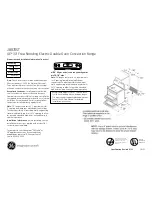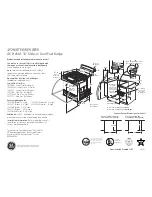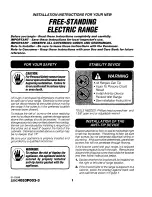
31
Care & Cleaning
General Cleaning
Refer to
Table 5
in this chapter for more detailed information
about cleaning specific parts of the range.
Before manually cleaning any part of the
range, be sure all controls are turned off and the range is cool.
The range may be hot and can cause burns.
Ammonia must be rinsed before operating the
oven. Provide adequate ventilation.
Aluminum Foil and Utensils
Never cover any slots, holes, or passages in the
oven bottom or cover an entire oven rack with materials such as
aluminum foil. Doing so blocks air flow through the oven and
may cause carbon monoxide poisoning. Aluminum foil linings
may trap heat, causing a fire hazard.
Protective Liners — Do not use aluminum foil to
line the oven bottom. Only use aluminum foil as recommended
in this manual. Improper installation of these liners may result in
risk of electric shock, or fire.
•
Aluminum foil - Use of aluminum foil on a hot cooktop can
damage the cooktop. Do not use thin aluminum cooking
utensils or allow aluminum foil to touch the surface burners
under any circumstances.
•
Aluminum utensils - The melting point of aluminum is much
lower than that of other metals. Care must be taken when
aluminum cookware are used on the cooktop. If aluminum
pans are allowed to boil dry when using the cooktop, the
utensil will be damaged or destroyed.
Cleaning the Cooktop and Surface Burners
To avoid possible burns, do not attempt any of
the cooktop cleaning instructions provided before turning OFF
all of the surface burners and allow them to completely cool.
Any additions, changes or conversions required
in order for this appliance to satisfactorily meet the application
needs must be made by an authorized qualified agency.
Routinely clean the cooktop. Wipe with a clean, damp cloth and
wipe dry to avoid scratches.
Keeping the surface burner head ports and slots clean will
prevent improper ignition and an uneven flame.
Cleaning Recessed and Contoured Areas of Cooktop
If a spill occurs on or in the recessed or contoured areas, blot up
spill with an absorbent cloth. Rinse with a clean, damp cloth and
wipe dry.
To clean surface burner grates:
•
Clean only after the grates are completely cool.
•
Use nonabrasive plastic scrubbing pad and mild abrasive
cleanser or clean in the dishwasher.
•
Food soils containing acids may affect the finish. Clean
immediately after the grates are cool.
•
Thoroughly dry grates immediately following cleaning.
To clean burner caps:
•
Remove caps from burner heads after they have cooled.
•
Clean heavy soils with a plastic scrubbing pad and
absorbent cloth.
•
Thoroughly dry burner caps immediately following cleaning
including the bottom and inside of cap.
•
Do not use abrasive cleaners. They can scratch porcelain.
•
Do not clean burner caps in the dishwasher.
•
Do not operate surface burners without burner caps
properly in place. Read important notes.
Cleaning Surface Burner Heads
For proper gas flow it may be necessary to clean the burner
head and slots. To clean, first use a clean damp cloth to soak up
any spills. Remove any food from between the burner slots using
a small nonabrasive brush like a toothbrush and afterwards
wipe up using a damp cloth. For stubborn soils located in the
slots, use a small-gauge wire or needle to clean.
Any spill on or around the electrode must be carefully cleaned.
Take care not to hit the electrode with any thing hard or it could
be damaged.
Figure 40: Cooktop burner head
ignition port
slots
orifice port
Содержание 790.3262 Series
Страница 38: ...38 Before You Call ...
Страница 39: ......









































